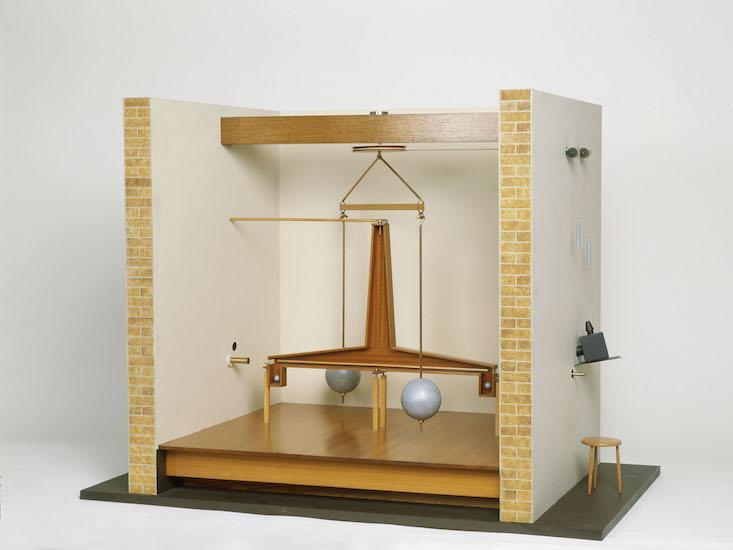How to weigh the world
- Transfer

Atlant knew the answer. Having difficulty fulfilling the task of holding the Earth, this titanium most likely knew very well how much it weighs. But we were not so lucky as him. How can a mere mortal, tiny man on the surface of the Earth, calculate his approximation for the weight of the Earth? And where could we place such scales?
We did not have an exact answer until the Englishman John MichellI did not figure out how to calculate it. Today, few people know him, but in the 18th century he was one of the cleverest priests. As a geologist, astronomer, mathematician and theorist who was friends with members of the Royal Scientific Society in London, he was the first in many things: he first suggested that earthquakes spread like elastic waves through the Earth’s crust (for which he was called the “father of modern seismology”) first suggested that many stars are actually double, and first introduced such a huge and massive star that even the light cannot escape from its gravitational pull - the “black sun”, something like the first black hole model.
This Protestant priest from West Yorkshire was a fan of the laws of Newton, first introduced in 1687. The law successfully predicted the movement of comets and cannonballs, but by 1780 the gravitational pull between two small bodies was still not demonstrated in the laboratory, according to Russell McCormmach, author of the 2011 Weighing the World book . For a long time, being interested in geology, Michelle has been searching for decades to find a way to calculate the density of the planet - and, therefore, its weight. He came up with a scheme for measuring gravitational forces at a small distance, and in the process weighed the Earth. The device he designed was simple but elegant. It consisted of only four lead balls, a movable pole and several wires enclosed in a casing, preventing the influence of air currents.
In the final version, a two-meter wooden pole was suspended on a wire, with a pair of balls 5 cm in diameter, connected to its ends. Larger balls, 30 cm in diameter, were located close to small balls. The idea was that an extremely small gravitational attraction between each pair would gradually begin to turn the pole. This movement will stop when the elasticity of the wire equals the force of attraction between the balls. It was one piece of information. The force of attraction of the balls and the Earth is already known - it's just their weight. For the Michell experiment, it was very important to get two sets of data. Comparing the data, separately measuring the force of attraction of the balls, the experimenter could then calculate one unknown in the equation of gravity - the mass of the Earth. Exact balance led to an amazing result.

Model 1:48 torsion scales, built by Henry Cavendish in 1798.
But this experiment was hard to conduct and manage. In 1784, Michell wrote to his colleague from the Royal Society, Henry Cavendish (the discoverer of hydrogen), that he hopes to weigh the world " during this summer ." But poor health and “ natural lethargy, ” as Michell called it, did not allow him to complete the project. He was also distracted by the project to build the largest telescope in the world. He died in 1793 at the age of 68, having failed to measure.
The device Michella as a result was in the work of Cavendish, whom his biographers describedas "one of the richest people in the kingdom ... a fan of science and a paramount neurasthenic." He was terribly shy, especially afraid of women. Living alone, he completed the instrument, the final form of which improved the idea Michella. Now Cavendish is credited with the lion's share of merit for conducting the long-awaited experiment - and for good reason. The device was closed in a small shed in the territory of his estate, and he had to control the scales from the outside with levers, and observe the small movements of the pole (shifting no more than half a millimeter) through a hole in the opposite walls of the shed with a telescope.
The work was difficult and meticulous. He again and again measured the torque, the moment of inertia and the angles of deflection of the pole, manually inserting the result into the formulas in search of an answer. His workpublished in the journal Philosophical Transactions in 1798, the Scottish physicist of the time described as a "model of accuracy, consistency and brevity." The density of the Earth calculated by Cavendish — even with such ancient equipment — did not differ by more than 1% from today's values of 5.513 g / cm 3 , five and a half times denser than water. If we multiply this value by the volume of the Earth (about 1.1 * 10 27 cm 3 ), then we will get about six thousand trillion trillion grams.
Today, scientists continue to conduct this classic Cavendish experiment, although by completely different methods and for other purposes. They are trying to clarify the magnitude of the gravitational constant G, the fundamental factor in the Newtonian universal law of gravityF = G m 1 m 2r 2 connecting force with mass and distance. This constant is not as well known as other fundamental constants, and clarifying its value is vital, “since G plays a key role in theories of gravity, cosmology, particle physics and astrophysics, as well as in geophysical models,” wrote Guillermo Tino, a physicist from Florence University in the work of 2014.
His team of scientists from Italy and the Netherlands conducted an experiment using "laser-cooled atoms and a quantum interferometer." In other words, by measuring the gravitational attraction between a cloud of rubidium atoms and heavy tungsten cylinders, they obtained a value for G equal to6 , 67191 ∗ 10 - 11 m 3 to g - 1 s - 2 with an error of 150 ppm. This force is the weakest of the four fundamental interactions, which clearly demonstrates its tiny value. It is a pity that Atlanta is no longer with us today, so that it can confirm our discoveries.
